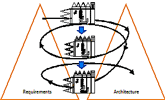This is what Jobs said:
"I think really great products come from melding two points of view-the technology point of view and the customer point of view. You need both.
"You can't just ask customers what they want and then try to give that to them. By the time you get it built, they'll want something new. It took us three years to build the NeXT computer. If we'd given customers what they said they wanted, we'd have built a computer they'd have been happy with a year after we spoke to them-not something they'd want now..."
"You can't just ask customers what they want and then try to give that to them. By the time you get it built, they'll want something new. It took us three years to build the NeXT computer. If we'd given customers what they said they wanted, we'd have built a computer they'd have been happy with a year after we spoke to them-not something they'd want now..."
Let me put this in QFD perspective.
We see two common flows in the way QFD is practiced: forward and reverse. Forward QFD begins with the voice of the customer which is often a mixture of "what they want," that is product performance, features, and technology. Because customers rarely know what the future may bring, their voice is typically tied to the past or present.
As Jobs points out, the product may be sufficient for the past, but insufficient at the time of launch or during its useful life. You can ask customers what they want as a starting point of a QFD analysis. The tool for this analysis is the Customer Voice table; its purpose is to translate voice of customer (VOC) into true customer needs. In this table, we explore with customers why they want something.
For example, a customer in a café may state "I need a hot cup of coffee," but what they really need is "I am cold and I want to warm up." Using Jobs logic, you could produce a cup of coffee that was too hot to drink, thus forcing the customer to wait until it cooled down. You would give them what they asked (hot), but not really meet their needs (warm up).
In modern QFD, we define a customer need as being product-independent, and that is the first step in creating great product. Read More ...
























